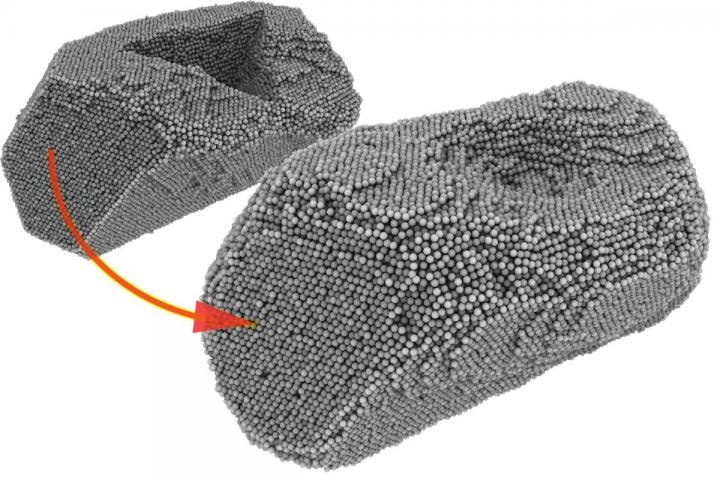Sep 15 2017
Self-healing materials are capable of repairing autonomous defects, such as dents, cracks or scratches, and then resume their original shape. To accomplish this, these materials must comprise of several components whose collective properties deliver the desired characteristics.
Recently, scientists from the Karlsruhe Institute of Technology (KIT) and the Technion – Israel Institute of Technology discovered that even small particles of pure gold contain amazing self-healing capacities.
 Gold atoms have moved into the dent produced before, refilling it almost completely. (Photo: KIT)
Gold atoms have moved into the dent produced before, refilling it almost completely. (Photo: KIT)
Lending shape memory to materials is considered to be an extremely complicated, painstaking effort. In pure metals, it has so far been impossible for self-healing capacities to repair mechanically caused defects. However, now scientists have observed these capacities in pure gold. A report on this has been published in the journal “Advanced Science”.
“The search for materials of this kind so far has been concentrated on polymers made up of many components and complicated structures,” states Christian Brandl of the Institute for Applied Materials – Materials and Biomechanics (IAM-WBM). All their self-healing powers were based on the combined transformation of the phases of one or more materials making them up. This is caused, for example, by precipitation, heating or melting, which may modify materials properties. The shape memory effect, in metal alloys, is based on the phenomenon that they can be present in two varied crystal structures as a function of a particular temperature. When this is altered, the metals “remember” their earlier shape they had at that particular temperature. However, this self-healing effect is never complete in alloys or in composites.
Shape memory or self-healing in pure metals was completely unknown until now. This is the effect that has been presently observed in gold particles by a group of scientists headed by Dr. Christian Brandl (KIT) and Eugen Rabkin of the Technion – Israel Institute of Technology. These multi-shaped particles almost completely resumed their distinct original shapes. Deformation of any kind was not observed.
The fascinating thing about this is that the restored particle shapes did not correspond to that with the lowest surface energy, as would have been expected
Brandl
Mechanical defects in the particles were produced by the scientists first in simulations by high-power computers and then, in reality, along with the measurement tip of a scanning force microscope. They discovered that annealing air temperatures much below the melting temperature of gold resulted in gold atoms moving along surface steps and back into the dents, refilling them almost completely. Such surface steps are observed in a number of deformed metals. Thus, Brandl also hopes other metals to comprise of the self-healing properties observed here. The scientists anticipate that their findings will permit the designing of robust components for structures smaller than one thousandth of a millimeter.
Video link: https://www.kit.edu/downloads/pi/Self-healing_nanoparticle.mp4
Video description: The video shows how, in molecular dynamics simulation, heating of the deformation first applied (dent) produces random movements of the gold atoms (so-called diffusion) slowly healing back into the original shape. The atoms are stained as a function of their height. In the smaller window, those atoms are darkest which moved over the longest distance, which shows that the atoms move along the surface steps.